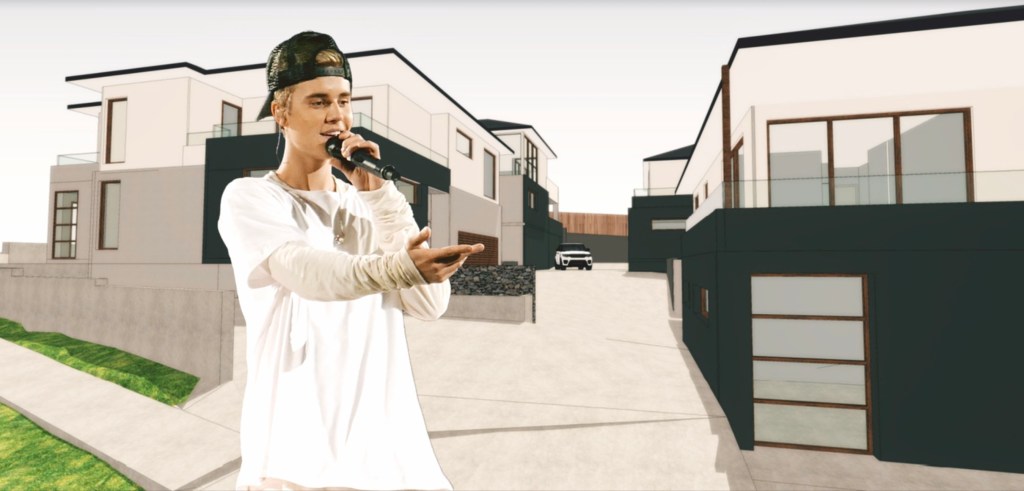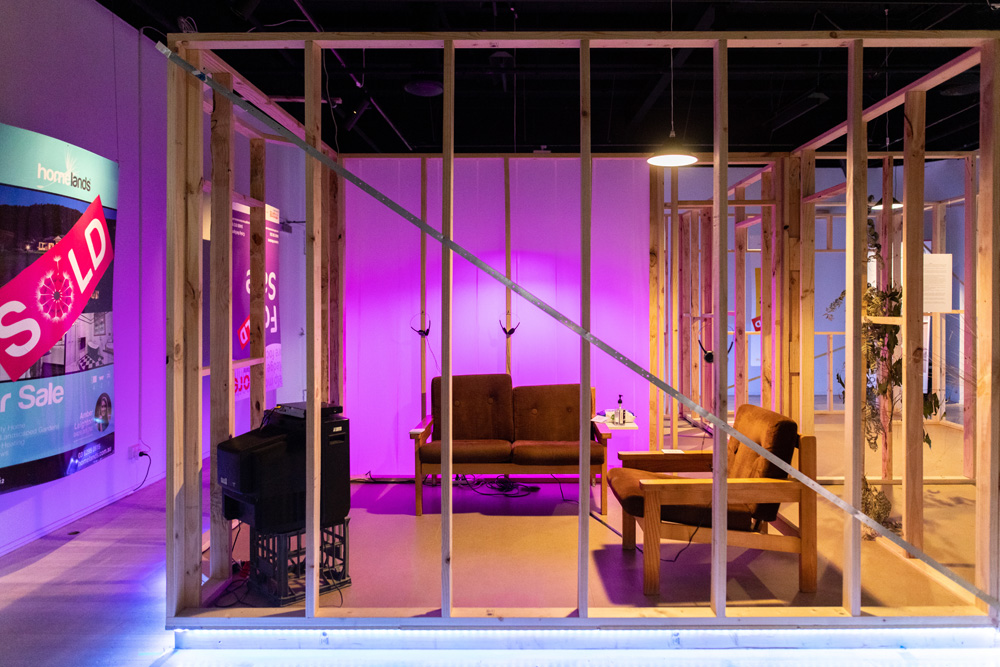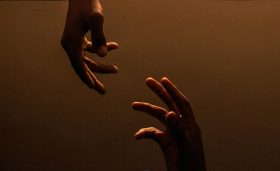Stepping into Contemporary Art Tasmania, you never know exactly what you’re going to get. On this occasion I’m met with the intoxicating smell of timber. The gallery is filled with a magenta glow, and there’s a slightly scaled-down framework of a house tucked behind the door.
HOME|LAND interrogates personal and cultural ideas of heritage by six Tasmanian artists. The show is curated by Alexandra Hullah and is the culmination of their 2022 Curatorial Mentorship at Contemporary Art Tasmania – a program that has been running since 1995 and providing support for new curatorial voices.
Ideas of sharing are connected through this house in the gallery space, with responses to the housing boom/crisis also fiercely articulated. The value of local arts spaces and their ability to undertake projects responding to pertinent issues should not be overlooked.
One of the first works encountered is Midland Mourning, a cairn made by Caleb Nichols-Mansell. Through the work we can see a process of negotiation unfold, as the artist sourced rocks from a colonial property in the Midlands to form this memorial to Country. Nichols-Mansell provides personal reflections of the area and invites viewers to contribute an offering.
The work presents the idea of heritage as being imbued with personal memory, but also as a shared concept that is actively shaped.
The central themes explored by the exhibition demonstrate a connection to ideas of ‘home’ and ‘land’ respectively. I found it notable that the housing structure in the gallery is based on a floor plan of 55 Mount Stuart Road – a property that was illegally demolished by its owner in 2016. Four gleaning townhouses now stand in place of the 1850s heritage-listed cottage.
This story adds another layer of specificity to the show as a controversial symbol in recent Tasmanian memory. Who decides which landscapes and structures are worthy of preservation, and what does it mean when we don’t agree?
Responding to these bureaucratic concerns regarding heritage frameworks is Richie Cuskelly’s On Good Authority. Positioned at the front of the house,the video work follows a fictional transcript of a mediation session between 55 Mount Stuart Road’s developer Darko Krajinovic along with Justin Bieber and Greta Thunberg.

Saturated by a playful tone, Cuskelly’s work fittingly includes a distorted remix of Bieber’s 2015 hit, Sorry. There’s a humorous mix of absurdity, yet underlying believability of the scenario. The work is displayed on a retro tv, with a DVD player positioned on top of a milk-crate. There are brown velvet couches to recline on, with the set up reminiscent of a stereotypical share house lounge room. The headphones make the viewing experience a personal one that reimagines communal spaces.
In the neighbouring room, questions of defining heritage are posed by Nunami Sculthorpe-Green through their installation paliti milaythina-ti: Spirit is in Country. Two stories are found in the room that detail Sculthorpe-Green’s relationship to piyura kitina and memories of their family farm.
Three ceramic works represent places where land is managed by Aboriginal people. The vessels are held in each corner of a triangular board suspended from the ceiling, as a looping video of a fire burns from the centre. Native flora from these landscapes is incorporated into the room, with the weaving of native grasses also meticulously embedded into one of the vessels. This layering of materials communicates an exquisite sense of care and connection through reflecting on cultural inheritance.
In moving to addressing issues of the housing market, Flo Robinson’s work sees the gallery temporarily house vegetable planters. Artificial lights shaped like mushrooms are spaced in between the vegetables. There’s little light in the room, and it’s hard to know if these lights are helping or hindering the growth of the plants.
The other key source of lighting is the fluorescent pink from Priya Vunaki’s work Do Not Disturb, the site of the pleasantly elevator-esque looping composition. Blue lights provide illumination from underneath the floor of the house to similarly reinforce the share house setting.
Georgia Lucy’s Wobble Boards are repurposed real estate signs that hang humorously around the gallery’s perimeter. The artist cites the mechanical ‘Cat and Fiddle clock’ in the arcade of nipaluna/Hobart as the inspiration for activating the signs. There are subwoofers installed within several of them, and they wobble every hour.
Instead of family-fun entertainment, the noise evoked is that of utter chaos. When viewing this work from the housing structure, I could feel the rumbling under my feet. The uncomfortable faces of real estate professionals have no choice but to keep smiling throughout the event.
In trying to find appropriate means to discuss and protect heritage, the exhibition leaves one with difficult questions regarding extraction and exploitation. How do we relate to each other, while ensuring we fulfil our basic needs of shelter and safety?
The house in the gallery provides an interesting curatorial framework, with artists responding to the specificities of their lived experiences in response to its foundational structure. HOME|LAND compellingly questions the nature of home, inheritance and what it means to live in lutruwita/Tasmania today.
HOME|LAND
Contemporary Art Tasmania
24 September – 30 October, 2022
27 Tasma Street, North Hobart
Curator: Alexandra Hullah
Artists: Georgia Lucy, Caleb Nichols-Mansell, Flo Robinson, Nunami Sculthorpe-Green, Priya Vunaki and Richie Cuskelly
Free
ArtsHub is a publishing partner of the 2022 National Gallery of Australia’s Digital Young Writers Mentorship Program, supported by Learning and Digital Patron, Tim Fairfax AC.





